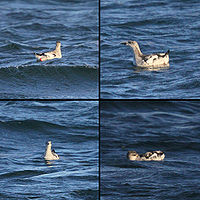Black guillemot
| Black guillemot | |
|---|---|

| |
| Black guillemot resting on a cliff in Reykjanes, Iceland | |
| Scientific classification | |
| Domain: | Eukaryota |
| Kingdom: | Animalia |
| Phylum: | Chordata |
| Class: | Aves |
| Order: | Charadriiformes |
| Family: | Alcidae |
| Genus: | Cepphus |
| Species: | C. grylle
|
| Binomial name | |
| Cepphus grylle | |

| |
| Synonyms | |
| |
The black guillemot or tystie (Cepphus grylle) is a medium-sized alcid. The genus name Cepphus is from Ancient Greek kepphos, a pale waterbird mentioned by Greek authors including Aristotle. The species name grylle was the local dialect name for this bird in Gotland at the time of Linnaeus's visit there in 1741.[2] The English word "guillemot" is from French guillemot probably derived from Guillaume, "William".[3]
Adult birds have black bodies with a white wing patch, a thin dark bill, and red legs and feet. They show white wing linings in flight. In winter, the upperparts are pale grey and the underparts are white. The wings remain black with the large white patch on the inner wing. They are 32–38 cm (13–15 in) in length, and with a 49–58 cm (19–23 in) wingspan.

Their breeding habitat is rocky shores, cliffs and islands on northern Atlantic coasts in eastern North America as far south as Maine, and in western Europe as far south as Ireland. They are one of the few birds to breed on Surtsey, Iceland, a new volcanic island. In the UK it is a fairly common breeding bird in western and northern Scotland and Ireland. In the rest of Great Britain they only breed at St. Bees Head in Cumbria, the Isle of Man and on east Anglesey in north Wales. Some birds breed in Alaska where their range overlaps with the pigeon guillemot. They usually lay their eggs in rocky sites near water.
There are five listed subspecies of the black guillemot:[4]
- C. g. mandtii – (Lichtenstein, 1822): northeast Canada to Svalbard to northern Siberia and northern Alaska
- C. g. arcticus – (Brehm, 1824): northeast United States, southeast Canada & south Greenland to the Ireland and Britain, southern Scandinavia and the White Sea
- C. g. islandicus – (Hørring, 1937): Iceland
- C. g. faroeensis – (Brehm, 1831): Faroe Islands
- C. g. grylle – (Linnaeus, 1758): Baltic Sea
These birds often overwinter in their breeding areas, moving to open waters if necessary, but usually not migrating very far south.
They dive for food from the surface, swimming underwater. They mainly eat fish and crustaceans, also some mollusks, insects and plant material.
The call in the breeding season is a high whistle. The red gape is also prominent then.


Behaviour
One of the early ornithologists that described aspects of the behaviour of the black guillemot was Edmund Selous (1857-1934) in his book The Bird Watcher in the Shetlands (1905).[5] In the chapter titled 'From the Edge of a Precipice'[6] he writes for instance that sometimes the black guillemots carry a fish they have caught in their beak for hours. He also gives further details about the behaviour.
References
- ^ Template:IUCN
- ^ Jobling, James A (2010). The Helm Dictionary of Scientific Bird Names. London: Christopher Helm. pp. 96, 180. ISBN 978-1-4081-2501-4.
- ^ "Guillemot". Oxford English Dictionary (Online ed.). Oxford University Press. (Subscription or participating institution membership required.)
- ^ "Coursers, noddies, gulls, terns, auks and sandgrouse". worldbirdnames.org. International Ornithological Congress. Retrieved 2015-01-13.
- ^ Selous (1905).
- ^ Selous (1905), p. 68f.
Literature
- Leonard, K. 2008. Black Guillemots on the Copeland Islands in 2008. Annual Report for 2008. Copeland Bird Observatory. p. 50.
- Selous, Edmund (1905). – via Wikisource.
{{citation}}: Invalid|ref=harv(help)

